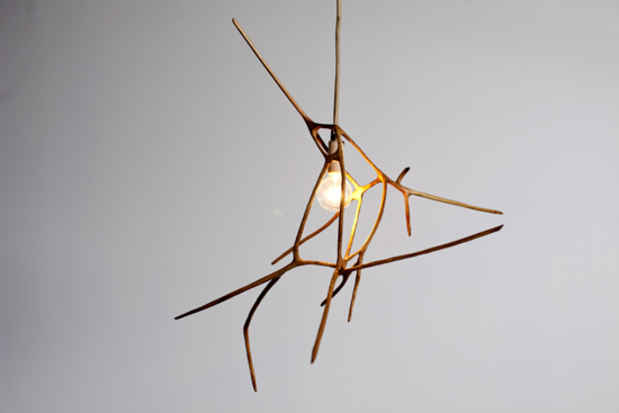Darren Blackstone Foote "Flesh and Bone"
DODGEgallery

This event has ended.
DODGEgallery presents Flesh and Bone, Darren Blackstone Foote's first solo exhibition at the gallery.
Flesh and Bone is an exhibition of matter-of-fact poetics. The impartial course of time is a cruel, unapologetic fact that finds voice in the harshness of nature, and a foe in the self-aggrandizement of humanity. Foote's work is not a proposition of value, but is itself a beautiful, fraught synthesis of oppositional, interlocking elements: life and death, making and unmaking, adding on and taking away. Flesh and Bone is an exhibition wherein contradiction is balance and opposites are interdependent. Each work seeks to answer its own unanswerable questions, but does so with a vernacular parallel to our everyday understanding of history and experience.
I'm interested in finding points of re-connection not only to nature, but the natural mechanisms of life and death. I'm specifically interested in how we, as thinking, powerful agents contend with the world we've created.
Lightening Strike (Quadriptych) is made with the skins of four cows that are each stretched over a triangular form and etched with the image of lightening bolts. The notion of Galvanism, first explored by the doctor and physicist Luigi Galvani in the late 1700's, is the belief that it is possible to reanimate organic matter with electric current. Foote has branded the electric currents of lightening onto the skins of dead animals and stretched them into forms that symbolize life. The triangle is the alchemical symbol for fire (the upside-down triangle is symbol for water). The tetrahedron, a four-sided solid made up of four equilateral triangles, is one Plato's Five Solids in his Theory of Forms. It represents the element of fire in the creation and make-up of everything in the universe. The subtlety of Foote's lightening bolts makes them appear integrated into a dark expanse that almost fills the viewer's peripheral vision. The suggestion of an open landscape, a sense of distance and horizon in the composition, add to Foote's interest in representing a kind of boundlessness. This is Big Sky country at night, the forces of nature at work. Also tying into Foote's piece is the reference to Lichtenberg Figures, fern-like patterns that appear on the skin of lightening strike victims. Connecting a god-like event with the closeness and finitude of flesh, Lightening Strike (Quadriptych) is a dead animation that gestures towards the potential for re-birth.
In Foote's piece Globe, the monstrous intersection of two human hands are encircled and upheld by a globe-like wooden frame and stand. He cast the hands in plaster, and mended their flaws detail by detail, as if carefully restoring an object abused by time. Directly referencing Raphael's Vatican fresco The School of Athens, the gestures represent the conflicting philosophies of Plato and Aristotle. The hands are now combined, illustrating a simplified message: up and down, heaven and earth, empirical knowledge and universal truth. The freakish interruption of each hand, one by the other, makes them appear surgically connected, and unifies two distinct perspectives. Their Frankenstein proportions retain their humanity, aggrandized and exaggerated, yet still bound by the rings of a tree older than all of us.
With Source, narrow shafts of wood burst from its center where a small, round bulb hovers, suspending the piece from the ceiling. The work is carved entirely from a single root system, reduced to its essential form. Source is a three-dimensional fracturing of space that nests a light source. It is the beginning of something, a rupture or explosion from a point. A seed. By carving the wood down to its deepest, most fragile interior, Foote reduces the wood to its beginnings, imbues it with its own source of light, symbolically reversing its natural course, and aiding in the possibility of a new kind of growth and regeneration.
Honk if You Don't Exist is a segment of a tree tagged with a bumper-sticker bearing the impossible command of the work's title. The 'bumper' lies bent on the floor, as if dismembered from a car, yet still holding onto its belief system, now more relevant than ever. The ride ended, existence was truncated. From another angle, trees are sacrificed for roads, lives are sacrificed for cars. While the piece contains a bow to loss, it simultaneously proclaims that, in fact and in the end, it doesn't matter...perhaps none of it, or you, existed in the first place. The bumper is not really a bumper, need it be mentioned. It is part of a dead tree that had been plucked from the forest floor where it would have contributed to the generation of new growth, which was perhaps its purpose—or obviously not. Foote writes, "The absurdity of the piece is spelled out. Asking someone to 'honk' is a call to action, a proclamation of life, a blast of the very existence youʼre claiming not to have. Honk if you're a dead tree."
Media
Schedule
from November 10, 2012 to December 22, 2012
Opening Reception on 2012-11-10 from 18:00 to 20:00